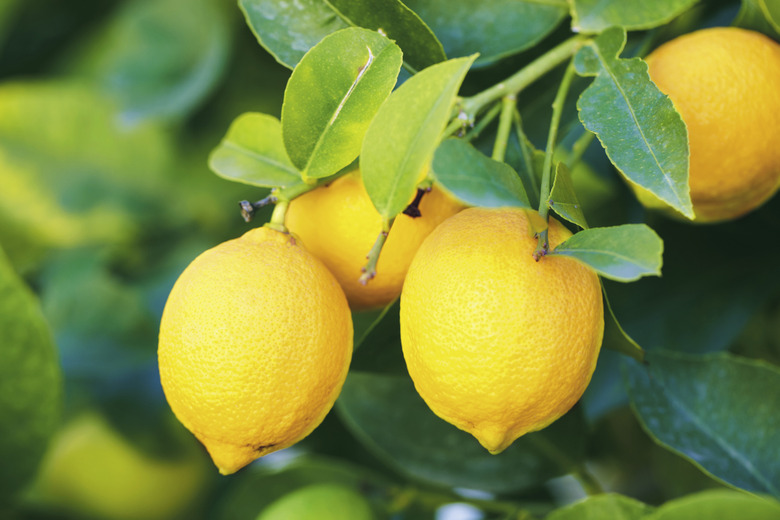When To Transplant Lemon Trees?
We may receive a commission on purchases made from links.
The true lemon tree (Citrus x limon) produces acidic yellow fruits that are perfect for cooking or for use in cold beverages and desserts. Hardy in U.S. Department of Agriculture plant hardiness zones 9 through 11, lemon trees grow in the garden or in containers. Transplant lemon trees when they're actively growing, preferably in spring so they have time to become established in the garden before the heat of summer and chilly days of winter arrive.
Tip
Transplant lemon trees when they are actively growing. While you can technically transplant potted trees at any time of the year, they will do better when planted outdoors in the cooler days of spring versus the hottest days of summer.
About Lemon Trees
About Lemon Trees
True lemon trees grow 10 to 20 feet tall and 10 to 15 feet wide when grown in the garden. Citrus x limon 'Eureka' and 'Lisbon' can also be grown in 10- to 15-gallon containers. If grafted onto dwarf rootstocks, they require less pruning to maintain their size – an advantage when growing in a greenhouse or warm sunroom. Citrus x limon 'Variegated Pink Eureka,' also known as 'Pink Lemonade,' has pink-fleshed, green-striped fruits that ripen to yellow and green and white variegated leaves.
A sweeter alternative is Citrus x limon 'Improved Meyer.' A hybrid of a lemon and a mandarin orange, the trees are naturally small at 6 to 10 feet tall. While considered hardy in USDA zones 9 through 11, they can tolerate temperatures down to 20 degrees Fahrenheit for brief periods. When grown in a container, Improved Meyer rarely reaches 8 feet tall.
Safe Planting Practices
Safe Planting Practices
Put on safety gear, including safety goggles, long sleeves, long pants, closed-toe shoes and thornproof gloves. Some lemon trees are thorny, including Lisbon. Wrap the tree with a moving blanket or cardboard to avoid puncturing your skin or damaging the branches while moving it out of the grower's pot and into the planting hole or new container.
Before trimming the tree, pruning or harvesting ripe lemons, sterilize your cutting tools by dipping the blades into rubbing alcohol. You can also wipe the blades before making each cut with a rag soaked in alcohol.
Time to Transplant Lemon Trees
Time to Transplant Lemon Trees
While lemon trees are evergreens, they can be thrown into dormancy when temperatures drop below 55 degrees. If you're transplanting a bag-and-burlap or potted tree outside, wait until the weather warms in spring and the tree begins actively growing. You can plant potted trees later in the season; plant in the early morning when the soil and air temperatures are cooler.
Choose a sunny spot in the garden. In cooler climates, a well-draining location next to a sunny, south-facing wall provides a warmer microclimate for your lemon tree. Dig the planting hole twice as wide and just as deep as the root ball. Loosen the dirt on the sides of the planting hole with a shovel. Fill the hole with water and let it soak into the soil.
Place the lemon tree in the hole so that it sits at the same depth as it was in the grower's pot. Unwind any encircling roots and trim as needed. Backfill the hole with the excavated soil. Tamp lightly and water thoroughly.
The Best Time to Repot
The Best Time to Repot
When repotting your indoor lemon tree, try to repot in spring, but if the roots are crawling out of the pot, it's better done sooner than later. Fill a 5-gallon or larger container with a citrus potting mix or a combination of equal parts compost, peat moss or coconut coir and coarse sand or perlite. Plant the tree at the same depth as it was in the previous container. Repot every two to three years.
Keep potted lemon trees in a south-facing window or add extra light by suspending a grow light or fluorescent fixture a few inches above the tree. You can take your tree outside in spring for a summer vacation but take it back indoors when night temperatures drop into the 50s.
Care of Lemon Trees
Care of Lemon Trees
Lemon trees prefer evenly moist soils. Water when the soil is dry to a depth of 2 to 3 inches. Fertilize potted trees monthly during the growing season with a half-strength liquid fertilizer formulated for citrus. In the garden, fertilize with a nitrogen or citrus fertilizer every six to eight weeks from late winter through summer.
Alternatively, rake well-decomposed compost or manure over the soil, starting 12 inches from the trunk and all the way out to the drip line. Apply every two months from late winter until late summer. Do not fertilize in fall or early winter.
References
- Four Winds Growers: Growing Citrus
- Missouri Botanical Garden: Citrus limon
- Missouri Botanical Garden: Citrus × meyeri
- University of Florida IFAS Blogs: I Have Meyer Lemon Tree That Needs to Be Moved Because It Now Has a Tree That Has Gradually Shaded It. Can It Be Transplanted?
- Harvest to Table: Lemons for Backyard Gardens
- Oregon State University: Pucker Up, It's Time to Talk Lemons
